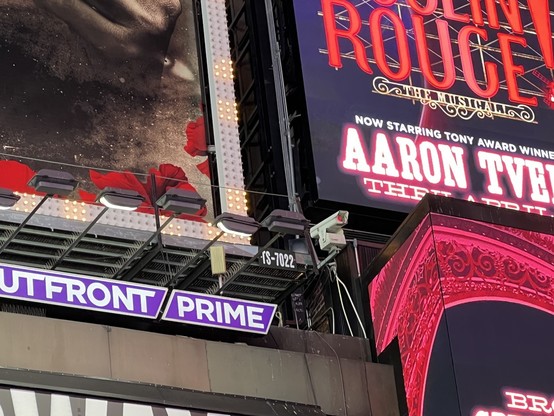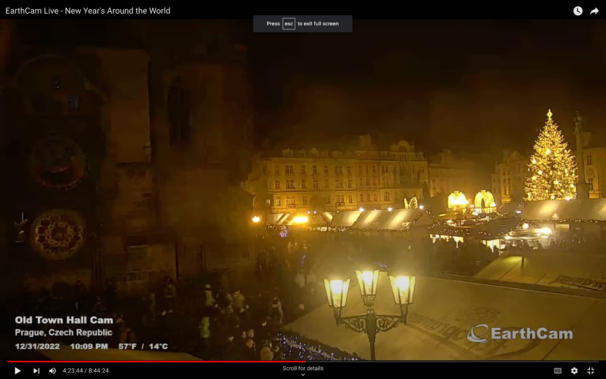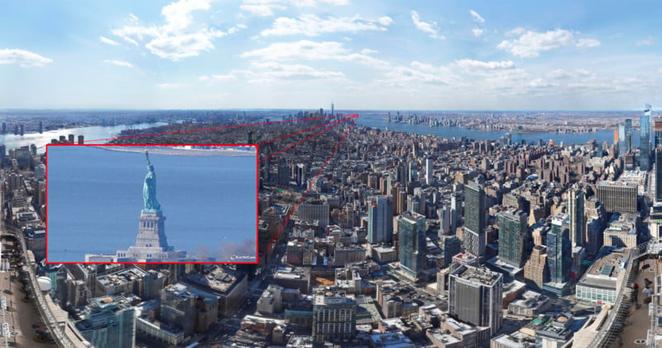Statue of Liberty National Monument today. Learn more at https://www.nps.gov/stli/index.htm and #nps #nationalparks #photography #landscapephotography #publiclands #interpretation #newtopographics #newyork #statueofliberty #earthcam Image credit National Park Service and EarthCam
#EarthCam
SPOTTED IN ILLINOIS:
We found some of our GWES Staff team heading up to #SirenCon2025 in Rhinelander, Wisconsin on an EarthCam in Rochelle.
Learn more about SirenCon and the official livestream by going to https://gwes.link/sirencon25
You can see a slight #aurora over NYC from this #earthcam https://www.earthcam.com/usa/newjersey/weehawken/?cam=lincolnharbor
#WDEFNews12 #WDEFWeather: From the #EarthCam view of NYC on this #September11, a rainbow on the right side of the #WorldTradeCenter webcam.
" Here's Looking At You!"
or... "Turnaround is Fair Play"
I have watched the Live EarthCam Video Feed from Times Square - countless times - day, night, in winter and summer, during both pandemic and tourism.
https://www.youtube.com/live/1-iS7LArMPA?feature=share
...
So walking past the view I've seen, I had an idea where the camera was and... I found it!
Also got to see the hedge art.
#MyPhotos #TimesSquare #NewYork #NYC #Fenfotos #photography #NYC #EarthCam
More NYC photography @ http://www.fenichel.com/NYNY.shtml
Here we go!
New Year's Eve around the globe: EarthCam, live:
👉 https://youtu.be/pvrSgoHvvJ0
Happy New Year!
#NewYearsEve #NewYearsEve2022 #LiveCam #NewYear2023
#EarthCam
20-Year Timelapse of the World Trade Center Took 13.3 Million Photos
Earthcam, one of the leaders in long-term timelapse camera systems, has released a new timelapse film that documents the last two decades of the rescue, recovery, and rebuild of New York's World Trade Center.
The September 11 attacks, often simply referred to as 9/11, were a series of four coordinated terrorist attacks againt the United States that took place on September 11, 2001. Two hijacked airplanes were crashed into the World Trade Center twin towers, which eventually led to their collapse within an hour and forty-two minutes after impact. The attacks resulted in the deaths of 2,996 people and injuries to more than 6,000 others.
After the site was cleared, a new World Trade Center tower was planned and constructed on the same site as the original twin towers and opened on November 3, 2014.
The above timelapse film is the longest-running timelapse project in Earthcam's history and includes footage that the company says has never been seen before and spans the last two decades. Earthcam previously released a 10-year timelapse that showed the construction of the September 11 Memorial and Museum in 2014.
EarthCam says that it has been on site since 2001 when its CEO and Founder, Brian Cury, installed a webcam just days after the attacks to webcast the rescue mission to the families of the missing.
The company says that as recovery became rebuilding, it worked on developing new robotic camera technology that it says was necessary to document the 16-acre site in the highest resolution possible.
“This is an emotional milestone for EarthCam, as the history of the company has been so intertwined with this site.” said Brian Cury, CEO and Founder of EarthCam, “We’re grateful to so many partners, friends, and to the extraordinarilyy dedicated team at EarthCam whose innovation drove this process for 20 years to deliver this historic record for the world.”
From that point forward, every few minutes for the next 20 years, Earthcam systems regularly captured photos and panoramic images of the area and the transformation of downtown Manhatten from over 100 viewing angles. The company says that the finished project required the capture of over 13.3 million photos.
All of those photos in addition to the original camera that Cury set in place in 2001 have been donated to the National September 11 Memorial and Museum.
“We appreciate EarthCam’s unprecedented contribution of 20 years of historic images, which have meticulously recorded the rebuilding that transformed this sacred space,” 9/11 Memorial President and CEO Alice M. Greenwald says, “This creative time-lapse both honors the legacy of those who were killed and embodies hope for the future, as we see these remarkable new structures that surround the Memorial as evidence of lower Manhattan’s resilience and renewal.”
_Image credits: Photos provided courtesy of Earthcam. _
#inspiration #news #earthcam #september11 #september11attacks #september11memorial #september11th #timelapse #timelapsefilm #twintowers #worldtradecenter
EarthCam Collabs with Sony in New All-Weather High-Res Timelapse Rigs
EarthCam, which recently made waves when it took the largest photo ever captured of New York City, has launched two additional high-resolution timelapse camera rigs that use a Sony Alpha 7R Mark IV at their core.
Following the launch of the EarthCam GigapixelCam X80 in May, the company has announced two more high-resolution timelapse camera rigs: a wide-angle 61 MegapixelCam and the 61 MegapixelCam Robotic, which adds a precision 360-degree pan and tilt base.
The non-robotic wide-angle camera features a Sony 20mm f/1.8 prime lens mounted to the Alpha 7R Mark IV to offer wide, high-resolution files. The lens on the robotic version isn't specified may be user-customizable, but PetaPixel has reached out to EarthCam to confirm.
EarthCam may use the Sony camera system at its core and therefore the image quality is well documented, but thanks to the Sony Camera Remote SDK, the company is able to build significant functionality around the camera. The EarthCam enclosure protects from the elements and comes equipped with what the company bills as a "maintenance-free" wiper, battery, and data backup. The camera can be controlled remotely and tasked with documenting ongoing progress or specific milestones.
Most of EarthCam's clients are commercial or industrial, but because of the advanced software features, the system has several creative applications as well. EarthCam doesn't publish how much each of its enclosures costs, but it's likely to be more expensive than most creators would be willing to afford. And while competitors like PhotoSentinal allow for several of the same features and comes much more affordably priced for the average small business owner, EarthCam takes performance to a different level.
Both of the new 61-megapixel systems use an industrial solid-state embedded Linus OS platform with an ARM9 CPU and 64-gigabytes of onboard backup storage. It can be connected via either ethernet or a wireless 4G or 5G connection and powered by a standard wall outlet or outfitted with solar if it is placed in an area where traditional power is not available. EarthCam also provides custom software that can be used to monitor and adjust the camera from a computer or mobile device.
Earlier this month, EarthCam published a video that shows the kinds of projects that can be made with its products and why high-resolution is of particular value. Beyond timelapses like the one below, EarthCam rigs outfitted with a robotic base (like the new 61-megapixel Robotic) can also produce extremely high-resolution gigapixel images by stitching together a large number of photos.
These camera rigs can also be used for live streaming, which EarthCam demonstrates with a camera that is currently live over Times Square in New York and is broadcasting in 4K.
While as mentioned EarthCam doesn't publish exact pricing, it does say that these new models are "mid-priced" and are designed to make it easier for small or midsize businesses to afford. Long-term timelapse production is a niche art, but it's still highly valuable for commercial photography businesses and if EarthCam can bring its pricing down to the point where it is at least comparable to cheaper options like PhotoSentinal, higher quality long term projects are likely to come as a result.
#equipment #news #earthcam #earthcam61megapixelcam #earthcam61megapixelcamrobotic #gigapixel #longtermtimelapse #panoramic #roboticcamera #timelapse
This 120 Gigapixel Photo is the Largest of New York City Ever Taken
EarthCam recently unveiled the GigapixelCam X80, which is a robotic camera that can produce more than 80,000-megapixel panoramas. To prove it, the company used the X80 to make the highest resolution photo of New York ever captured: 120,000-megapixels.
EarthCam's devices can be mounted pretty much anywhere and are typically used by construction companies to document long-term builds or used as live-streaming cameras in a host of global locations.
EarthCam.com, the global network of owned and operated live streaming webcams, was built as a way to transport people to interesting and unique locations around the world that may be difficult or impossible to experience in person. Providing a virtual window to the world, viewers can freely explore the globe from unparalleled vantage points, such as the torch balcony of the Statue of Liberty, which has been closed to the public since 1916. EarthCam.com derives revenue from advertising and licensing of its proprietary webcam content.
"This is our ninth year of creating gigapixel tech," EarthCam's Founder and CEO Brian Cury tells PetaPixel. "Our robotic use of it goes back years earlier. We've been on a mission to make the best outdoor webcams for clients and it is what has got us nine of the top 10 stadiums in the last few years."
The kind of client that would demand the products that EarthCam produces is, as expected, unique.
"There is a narrow group of amazing clients who wants the best, the highest quality they can be," Cury continues. Because of the challenging environments that EarthCam clients demand, having a fully robotic solution on a solidly-mounted housing is the only way to successfully operate a camera over time.
The X80 is the company's latest product that combines its specialized housing and computing with a Sony a7R IV and, in the case of the New York gigapixel image, the 70-300mm f/4.5-5.6 G E-mount lens. While the well-known Sony camera lives in the housing and is the core of the imaging capabilities, Cury was adamant that making the device was more than just throwing a camera in a weatherproof housing, but the culmination of a decade of experience in both hardware and software for this extremely specialized purpose.
While the X80 was originally built to capture 80 gigapixel photos, EarthCam stretched the device to the limits of its capabilities in this particular image, which Cury says is actually 120 gigapixels.
Click to view the fully interactive 120 gigapixel photo.
"If you printed this photo out, it would be the length of 272 New York hot dogs end to end," Cury says, laughing. In a more "boring" measurement, he says it comes out to 136 feet wide at 300 DPI.
The GigapixelCam X80 is $24,995 as fitted, but if a client does not need a robotic version, those are less expensive. EarthCam's line starts at $1,900 for a time-lapse camera with solar power and goes up from there.
The photo was taken from a mounting position on the Empire State Building, and the Sony a7R IV inside is able to be controlled thanks to Sony's software development kit (SDK).
"We put together the X80 using the a7R IV (before we used Nikon cameras)," Cury says. "We loved this camera, and Sony who has traditionally not been very fluid with APIs and code has released a lot of public code and more data beyond that lately."
Creating images like this is the premier capability of the camera, but it's also meant to be able to make them in any environment, repeatedly.
"We connect the camera to a computer and an industrial power supply so this thing can work long term, and we put a heater and a fan in there that can actively heat and cool the camera so you can put it anywhere from Saudi Arabia to Alaska," Cury explains. The company also has a solar option that would allow the X80 to be self-sufficient for extreme lengths of time, provided it can get enough sun.
"It's a robust system, with a super high-end filtration system on it as well. And we have controls inside to operate a wiper and a washer system so we can keep it clean."
When it comes to making a photo of this magnitude, Cury says that everything has to be ultra-precise. The video below shows the insane detail that the company was able to produce by combining its technologies with the Sony a7R IV:
"The whole system is automated. The camera is taking 61-megapixel images and the server is organizing them. It takes thousands of photos and stitches them together server-side," Cury explains.
Normally, attempting to load a photo of this magnitude would crash your browser, but because of how EarthCam's server is set up, it instead loads tiles as the viewer interacts with the image so that it can quickly load the resolution only where it is needed.
EarthCam provided a few zooms into key areas of the full gigapixel image to give an idea of how much sheer resolution the camera is capable of creating.
During the capture process, Cury says that even though it is automated and precise, it's not perfect.
"There are usually about 10% that are out of focus, but in this case, it was under 5% retakes that we had to do," Cury says, touting the capabilities of EarthCam's latest X80. "That's where the beauty of this camera comes in. If you're a photographer and you rented this spot to take this photo and you spent your day trying to make this, if you get anything out of focus it's a killer. It's very disappointing. With this camera, you just get on it the next day and you just get the photo you need, or you wait for the right day to do it again. You don't have to worry about missing anything. You can get that beauty shot whenever you want it."
Cury explains that a photo the size of this New York Gigapixel isn't made necessarily in a single day, though it certainly could be.
"This photo was probably created over several weeks, but that being said we could run a simple version where it runs 77 photos at 70mm to create a 2.6 gigapixel photo and that takes 15 minutes," Cury explains.
There are certain times and days that are picked out to assure that key areas of an image look their best.
"We played a lot with lighting. We went and got shots that were maybe better lit," he says. For example, both the Statue of Liberty and the World Trade Center were captured at different times to assure the best lighting on each.
While EarthCam's advanced technology does a lot of the heavy lifting, the finished gigapixel image of New York was not just all done by the robot, as the final photo still needs an artist's touch to be truly finished.
"The system will create it for you robotically, but you need an artist to really touch it up and make it look how it does," he explains. "The camera is the paintbrush, you need it and it's important. But it's not easy getting a camera on top of the Empire State Building. A lot of times we don't brag about the camera because it can be a bit of a distraction. But in this case, we are because it's a great camera and it's not easy to do this stuff."
To see more of EarthCam's projects, the company has a YouTube channel full of locations around the world that are captured through its robotic cameras here.
_Image credits: Photos courtesy of EarthCam and used with permission. _
#equipment #news #software #technology #earthcam #earthcamx80 #emount #gigapixel #roboticcamera #sony70300f4556goss #sonya7riv #sonyalpha7riv #sonyalpha7rmarkiv #sonyemount #timelapse




